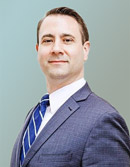Below you will find a real life case study of a couple who is looking for financial advice on how best to arrange their financial affairs. Their names and details have been changed to protect their identity. The Globe and Mail often seeks the advice of our VP, Wealth Advisor & Portfolio Manager, Matthew Ardrey, to review and analyze the situation and then provide his solutions to the participants.
![]()
Written by:
Special to The Globe and Mail
Published October 21, 2022

When Russ’s employer offered him a buyout package a few months ago, it was an offer he was keen to accept. He was earning $87,000 a year working in manufacturing.
Russ’s plan is to work part time for a few years. His wife, Vicky, plans to retire at age 55. Vicky earns $42,000 a year working in health care. Both have defined benefit pension plans but only Vicky’s is indexed to inflation. Russ is age 52, Vicky 47.
They have two children, one still at home and going to university. Among their short-term goals is doing some work on their Southern Ontario house.
Naturally, they wonder whether their pensions and savings will allow them to live comfortably for the rest of their lives. They also ask, what is a reasonable replacement ratio for employment income in the current high inflation environment – in short, how much will they need to maintain their lifestyle? Their tentative retirement spending goal is $68,000 a year after tax.
We asked Matthew Ardrey, a financial planner and portfolio manager at TriDelta Financial in Toronto, to look at Russ and Vicky’s situation. Mr. Ardrey holds the certified financial planner (CFP), the advanced registered financial planner (RFP) and the certified investment manager (CIM) designations.
What the expert says
Russ and Vicky want to make sure that they can make their retirement plan work given the early retirement age they have planned, Mr. Ardrey says.
Upon accepting his retirement package, Russ will receive a retiring allowance of $60,000, of which he can transfer $46,000 to a registered retirement savings plan – $6,000 via the eligible retiring allowance provision in the Income Tax Act and $40,000 from his available RRSP room, the planner says. The rest will be taxable to him. Additionally, he will get a $20,000 gross car allowance with a $6,000 withholding tax on it.
Russ plans to continue to work for the next five to 10 years part-time, earning $35,000 to $40,000 a year. In preparing his forecast, Mr. Ardrey assumed Russ works another seven years earning $37,500 a year. Additionally, he will have a non-indexed pension of $24,900 a year plus a bridge to age 65 of $17,300 a year.
When Vicky retires at age 55, they will begin drawing on their savings. She will have an indexed pension of $19,100 a year, plus a bridge to age 65 of $9,700 a year. Inflation is assumed to be 3 per cent.
Because they are retiring early, the planner assumes 75 per cent of maximum Canada Pension Plan benefits for Russ and 50 per cent for Vicky, starting at their age 65, along with maximum Old Age Security benefits at age 65.
Their current investment asset mix is 53 per cent stocks, 20 per cent bonds and 27 per cent cash, mostly in guaranteed investment certificates. The stocks are 40 per cent Canadian, 40 per cent U.S. and 20 per cent international. This asset mix has a future projected return of 4.11 per cent (net of 0.25 per cent in fees for exchange-traded funds).
Next, the planner looks at how much the couple will need to maintain their lifestyle. Russ and Vicky save $6,000 a year each to their tax-free savings accounts, plus another $1,000 a month combined to their non-registered bank accounts. “This, when added to their reported spending, shows a leakage in spending of an additional $10,000 per year over their reported spending of $68,000, which includes the TFSA savings,” Mr. Ardrey says. “Thus, we used a projected expense amount of $78,000 per year instead of the $68,000 indicated to achieve a more accurate projection.”
In 2023, Vicky and Russ plan to have home repairs of $22,500 completed. These could be funded by the savings in their bank account, the planner says.
Based on the above assumptions, Russ and Vicky likely are able to achieve their retirement spending goal of $78,000 a year, Mr. Ardrey says. “That being said, it is always important to stress-test their retirement projections, as investment returns are not earned in a straight line and will vary from year to year,” he says.
The planner stress-tests the forecast using a Monte Carlo simulation, which introduces randomness to a number of factors, including returns. For a plan to be considered likely to succeed by the program, it must have at least a 90 per cent success rate. If it is below 70 per cent, then it is considered unlikely to succeed. Results in between are considered somewhat likely to succeed.
“Unfortunately, Russ and Vicky’s base case plan fails the stress test, with only a 64 per cent probability of success,” Mr. Ardrey says. What causes the concern is the other 36 per cent of the time when it does not work, he says.
“To increase the probability of success, they could certainly do things like work longer, spend less, save more or the ever-unpopular die earlier,” the planner says. Or they could try to improve their investment returns.
A portfolio that is essentially 50 per cent stocks, 20 per cent fixed income and 30 per cent cash equivalents is not the best positioned for today’s investing and inflation environment, the planner says. Instead, they should look to minimize cash holdings, increase their fixed income allocation and include an allocation to more non-traditional asset classes such as private real estate funds, he adds. Historically, these investments have offered attractive returns with little to no correlation to the equity and fixed income markets. The biggest risk would be the lack of liquidity in these investments.
For example, private real estate investment trusts that invest in a large, diversified residential portfolio or perhaps specific areas such as wireless network infrastructure are preferable to ones that have a large exposure to retail.
By diversifying their portfolio and reducing cash investments, Mr. Ardrey estimates they could achieve at least a 5.25 per cent return net of fees and significantly reduce the volatility risk of the portfolio. “Additionally, many private real estate investments are tax efficient, having distributions that are part or all return of capital,” he notes.
With this adjustment, the change in the Monte Carlo simulation is material, moving up to a 90 per cent probability of success. Though this is at the low end of the likely-to-succeed range, they still have their house to fall back on in the unlikely case they do not achieve their goals.
Additionally, they should pay attention to which type of asset class is in each account. “I would not recommend cash in a TFSA, as the goal would be to maximize the tax-free withdrawals.” Instead, the couple should hold more growth assets in their TFSAs so they will increase in value. This way, when they make withdrawals, they will have a larger capital base from which to draw.
Client situation
The people: Russ, 52, Vicky, 47, and their two children.
The problem: Now that Russ has taken a package, can they afford to live comfortably for the rest of their lives without exhausting their savings?
The plan: Review their expenses to better understand their budget and stick to it. Improve their investment strategy to improve their long-term investment returns, which will remove the risk of running out of money before they run out of life.
The payoff: Easy street.
Monthly net income (past year): $7,500.
Assets: Cash $16,500; his TFSA $75,000; her TFSA $75,000; her RRSP $60,000; his RRSP $360,000; estimated present value of his DB pension $650,000; estimated PV of her DB pension $202,000; registered education savings plan $75,000; residence $750,000. Total: $2.26-million.
Monthly outlays: Property tax $360; water, sewer, garbage $80; home insurance $80; electricity, heat $230; maintenance $500; garden $55; transportation $750; groceries $1,125; clothing $120; gifts, charity $85; vacation, travel $300; dining, drinks, entertainment $175; personal care $15; club membership $10; sports, hobbies, golf $20; subscriptions $30; health care $65; health insurance $40; life insurance $140; communications $250; TFSAs $1,000; pension plan contributions $345; unallocated spending $725. Total: $6,500
Liabilities: None
Want a free financial facelift? E-mail finfacelift@gmail.com.
Some details may be changed to protect the privacy of the persons profiled.

Matthew Ardrey
VP, Wealth Advisor & Portfolio Manager
matt@tridelta.ca
(416) 733-3292 x230
